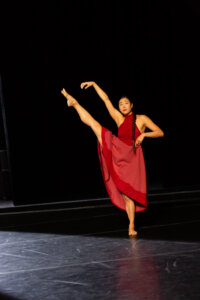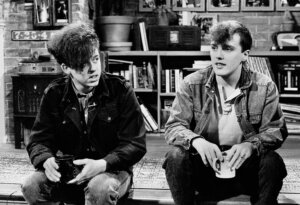The words are full of angst and alienation — so why is this show so joyous?
In ‘Love Train,’ Emmanuel Gat brings the songs of Tears for Fears to vivid life

Graphic by Angelie Zaslavsky
Critics are supposed to be neutral but, cards on the table, I wanted Emanuel Gat’s U.S. premiere at the Brooklyn Academy of Music to be great.
Primarily I was cheering it on because Love Train is a dance show set to the music of Tears for Fears whose music is second nature to me. Even after decades of listening to their songs and writing a short book about their first two albums, I still listen to them for pleasure. But also, I hoped for the best because, after interviewing Gat about how he went about creating the show, I wanted to see how that process could possibly work. How could he go into day one without any preconceived ideas apart from one song, and try to mine what was there in the group? How could he shape the roles and tendencies of 14 dancers into a dance troupe with a personality or organic character that could then enter into “dialogue” with the music?
On top of that, I was charmed by an artist who wants to give his performers “freedom [through] the act of accepting responsibility” and to do that in service of inspiring the audience.

I spoke to him the morning after the first New York show, when he was quietly elated. He said he views his role more like the coach of a soccer team than that of a godlike creator. “The coach doesn’t tell Messi or Mbappé how to kick the ball.” But, as choreographer, not only does Gat have to tweak the team, for each show he has to tweak the rules of the game. For this one, the outcome of the rules needs to elevate the audience’s mood and spirit: “Art used to have that role of uplifting people through religious practices but we’re missing that,” he told me.
A Tel Aviv muse
Gat, who has lived in France since 2008, is part of a diaspora of dancers and dramatists significantly influenced by the Suzanne Dellal Centre in Tel Aviv. Best known for inspiring works by Barak Marshall, Inbal Pinto and the Batsheva Dance Company, the Suzanne Dellal Centre has had an outsized impact on the global dance scene. Gat founded his own company in 2004, while affiliated with the Centre. Though his work has developed independently, the Centre’s hallmark informality and inclusivity still underpin his work even when it becomes emotionally intense, physically demanding or, as with this work, strikingly costumed.
At the beginning of the show, the stage is dark and empty. Behind a curtain with four vertical columns cut out of it, we can see dancers limbering up, foreshadowing moves we will see later in the show. As the haunting synthesizer percussion of “Ideas as Opiates” reverberates, the dancers slowly emerge. Not for the first time, I wonder how a show could have the uplift that Gat promised, given that its soundtrack is anchored in teenage angst at parental abuse written in homage to Arthur Janov’s primal scream theories.
Thomas Bradley’s striking costumes suggest a sort of baroque apocalyptic chic, something like a more fabulous version of Pablo Picasso’s “Family of Saltimbanques” where, instead of itinerant circus performers loitering with pathos in a desolate landscape, Mad Max road warriors find a 1980s boombox and dance to Tears for Fears.
Sounds, not story
Unsurprisingly there is no story and there are no words. Even the song lyrics, to which I was keenly attuned, are little more than sounds. (Gat had told me that responding to a human voice in the music added a layer of complexity to the dancers’ response. In general, though, they were not listening or responding to the words. They were dancing the same way they danced, in Gat’s 2021 “Act II&III or The Unexpected Return of Heaven and Earth,” to Maria Callas’ Italian arias, which none of them understood.) How successful or evocative was Gat’s troupe in introducing itself without words, without criteria?
During the opening two numbers — “Ideas as Opiates,” and “The Prisoner” — anxiety and hope permeate the stage. Individuals reach out, others respond. The troupe echoes, evolves and amplifies movements, it splits and reforms. Individuals and duos tentatively split off and are reincorporated. The dawning sax opening of “The Working Hour” marks an increase in confidence of the group and then, perhaps counter-intuitively for those of us who know the original and have seen it in “Donnie Darko,” “Mad World” increases that assuredness.

The first series ends with “Pale Shelter” as the group embodies the urgency and confident need of the music, ignoring the despair of the lyrics. Starting with a line at the back of the stage performing simultaneous movements, and ending with increasingly complex layers of rotations and interactions, there is a shared sense of rhythm even as individuals and groups spin out. More closely than at any other part of the show, there is an identification of the group with the power and the beat of the music — even as Curt Smith sings about radical alienation of an emotional connection doomed to fail: “You don’t give me love (you give me cold hands)/ And I can’t operate on this failure/ When all I want to be is/ Completely in command.” And then to the first fade-to-black of the evening.
Gat was clear that he would have failed in his aims if the dance merely illustrated the music — like we are used to in clubs or with the iconic Soul Train dancers. The energy of “Pale Shelter” is a glimpse of what might happen if he veered a little in that direction and it is, in truth, intoxicating. As if to prove their independence from the music, though, the soundtrack is not continuous from song to song, and the dance occasionally continues in silence.
During the transition from “Everybody Wants To Rule the World” to “Shout,” Eddie Orayan prefigures the latter’s intensity with fast, pressing solo traverses of the stage before giving way to Michael Loehr’s more measured skirt-clad lunges. Even when the music restarts, the dancers ignore the vehement exhortation to “Shout.” Indeed, the group declines entirely to address the strident beats of “Shout” that have forced decades of discos to clap, yell or stomp along. During one crescendo, Loehr merely prolongs the hold of a horizontal forearm.
Moments of virtuosity
Two moments of slow virtuosity stood out in an otherwise hectic bustle of a show. At one point Ichiro Sugae and Thomas Bradley hold balance poses facing each other. They are close, but angled in center stage so Bradley faces backstage and Sugae out toward the right of the audience. Slowly, four or five times, while locking gaze, they synchronously transfer their weight, moving through a knee stance, to a different balance. At another moment, Jin Young Won, dancing solo at the end of “I Believe” holds her foot extended. She lowers it as the music ends, but just as the tone fades without a clear caesura, Won’s foot never quite reaches the floor. We are held, tantalized by a toe end moving — unclad as with all the dancers’ feet —asymptotically toward the floor.

There’s an exuberance to the performance, a sense of overflowing energy. Gat’s business is people, and his task is to optimize the expression and the power of these elite dancers as a group. Dealing with people through their movement and presence allows Gat to set forth a reaction to the music, not just the lyrics. We’re more used to thinking about rock ‘n’ roll as having an overwhelming sense of desire trapped just beneath the beat. But, despite the psychological angst of the words, the enduring appeal of Tears for Fears work in the ’80s is its driving desire and vigor. Behind “The Prisoner” is a fierce teenage yearning for liberation.
In the midst of the movement through “Everybody Wants to Rule the World,” “Shout” and “Famous Last Words” to “Sowing the Seeds of Love,” there’s a swelling and an opening before the finale. In 2019, caught outside the Gare de L’Est in Paris, Gat stopped suddenly to listen to a recording of “Sowing the Seeds of Love” that was playing. It was music that he had grown up with, but not that he had listened to in the 1980s. From that audio epiphany, that there was something “curious” in the song worth investigating, came “Love Train.” Through the stops and starts of the pandemic, including a summer 2020 world premiere that the Israel-based dancers had to miss because they were in lockdown, and the eventual world tour two years later, he was building teams and exploring the musical moment that had grabbed him in Paris.
Breaking the fourth wall
At the end of “Famous Last Words,” as Bradley’s solo comes to a stillness and Roland Orzabal sings “we’ll carry war no more,” the back curtain has gone up and the house lights have slowly risen. For once, Gat’s occasionally stark, occasionally murky lighting is moot. The fourth wall is discarded, the dancers and the audience are all in the same, large room in Brooklyn having survived the pandemic. From small children to senior citizens in the notably diverse audience, from dancers in their early 20s to those in their mid 40s, humans of all shapes and sizes and colors are gathered to celebrate life together in BAM. It was a lovely moment — though one that wasn’t fully capitalized upon in the following, closing number.
For me, the show whirred by in the blink of an eye. Of course, even absent the dance, I was in heaven: a world-class stereo system was playing for me, and 1,500 spellbound neighbors, recordings that I know back to front. There were certain parts where my over-writerly mind wanted to know more explicitly what was going on. There were other parts where it felt like certain solos didn’t quite work properly. And the finale, to the words from “Sowing the Seeds of Love” from which the piece takes its name (“And the love train rides from coast to coast/ D.J.’s the man we love the most”) didn’t quite have the jouissance, the overflowing sense of energy, excitement and potential that I enjoyed in “Pale Shelter” at the end of the first block.
But there was no denying the gravity-defying bounce of the piece mixed with its occasional almost-frightening stillness; the carnivalesque insouciance of the teamwork and the intensity of the small group scenes; the joyful encumbrance of the extra skirts and bustles on all dancers alike that became, like bodies, just excuses for more flourishing and rejoicing in the human condition. It felt like the dancers were enjoying a party that the audience wished they had been invited to. And, of course, we were.






















